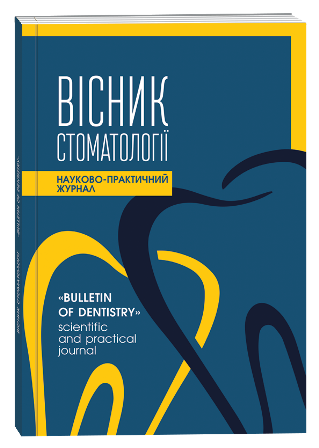CHARACTERISTICS OF THE ELECTROPHORETIC ACTIVITY OF BUCCAL EPITHELIUM CELLS IN CHILDREN STAYING IN DIFFERENT REHABILITATION AND EDUCATIONAL CENTERS
DOI:
https://doi.org/10.35220/2078-8916-2024-51-1.1Keywords:
children, psychoneurological disorders, electrophoretic activity of buccal epithelium cells, hard tissues of teeth.Abstract
Somatic pathology has a pronounced negative effect on the course of diseases of the organs and tissues of the oral cavity, both in adults and in children. Reflections of various pathological processes occurring in dental diseases against the background of various health abnormalities can be reflected in changes in EFACBE. The charge state of the cells of the buccal epithelium corresponds to the level of adaptive and compensatory reactions in the child's body and, as a result, to the level of non-specific general and local resistance. A change in the activity of cells of the buccal epithelium may indicate a change in the functional capabilities of the children's body. The purpose of the study is to determine the features of the electrophoretic activity of buccal epithelial cells in children with psychoneurological disorders. Research material and methods. In order to determine the state of the hard tissues of the teeth, 127 children with psychoneurological disorders (main group) and 74 somatically healthy children, who made up the control group, were examined. To study the state of hard tissues in the examined children, the intensity of caries was determined according to the DMF index. Indicators of electrophoretic activity of buccal epithelium cells were determined depending on the age and place of residence of the examined children. Research results and their discussion. On the basis of the conducted research, it was found that in children with psychoneurological disorders, the value of EFACBE, on average, is 25.04±1.32 % and is significantly lower compared to somatically healthy children (36.13±1.24 %). It was found that children aged 7-9 years of the main group of EFACBE have 54.79 %, and children 10-12 years old ‒ 26.18 % lower compared to children of the comparison group. The lowest EFACBE values were found in the children of the Educational and Rehabilitation center "Oberig", which on average was 21.81+1.28 %, and is 16.6 4% lower compared to children from the "Velikolyubinsky’ Multidisciplinary Educational and Rehabilitation center" and 27,74 % lower than children from the "Dobromyl Special School". Conclusions. 1. In children with psychoneurological disorders, the EFACBE value is lower compared to somatically healthy children. 2. In children of the main group, with the intensity of caries, on average, 4.92+0.62 teeth, EFACBE is 25.04+1.32 %. 3. The obtained data comparing the DMF and EFACBE indicators depending on the age and place of residence of children with this pathology encourage further study of the dependence of the electrophoretic activity of the buccal epithelium on various dental diseases.
References
Безвушко Е.В., Чухрай Н.Л. Електрофоретична активність клітин букального епітелію при карієсі зубів у дітей. Новини стоматології. 2010. № 3(64). С. 80-82.
Безвушко Е.В., Чухрай Н.Л. Електрофоретична активність клітин букального епітелію при карієсі зубів у дітей з районів з різним ступенем забруднення навколишнього середовища. Новини стоматології. 2011. № 2. С. 72-74.
Каськова Л.Ф., Акжитова Г.О., Амосова Л.І. та ін. Електрофоретична активність клітин букального епітелію у дітей із дисбактеріозом. Вісник проблем біології і медицини. 2013. № 2(103). С 318-320.
Ковач І.В., Крупей В.Я. Зарядовий стан клітин букального епітелію у дітей в динаміці лікування основних стоматологічних захворювань на тлі хронічної патології шлунково-кишкового тракту. Інновації в стоматології. 2014. № 2. С. 53-62.
Колупаєва Т.В., Цодікова О.А. Аналітична оцінка цитобіофізичних характеристик букального епітелію при прогнозуванні адаптаційних процесів у дітей. Медицина сьогодні і завтра. 2005. № 4. С. 72-75.
Костура В.Л., Безвушко Е.В., Чухрай Н.Л. Електрофоретична активність клітин букального епітелію при хронічному катаральному гінгівіті в дітей з надмірною масою тіла. Український стоматологічний альманах. 2017. 2: 53-57.
Машкаринець О.О. Електрофоретична активність клітин букального епітелію у дівчат пубертатного періоду. Вісник стоматології. 2012. № 2. С. 109–111.
Мірчук Б.Н., Деньга О.В., Макаренко О.А., Деньга А.Е. Стан функціональних реакцій і неспецифічної резистентності у дітей із зубощелепними аномаліями. Інтегративна Антропологія. 2011. № 2(18). С. 410-46.
Смоляр Н.І., Федорів Я М., Завойко Л.М. та ін Методичні рекомендації по статистичній обробці / [уклад. Смоляр Н. І., Федорів Я. М., Завойко Л. М. та ін]. Львів; 1995.17 с.
Чухрай Н.Л. Вікові особливості електрофоретичної активності клітин букального епітелію при карієсі зубів у дітей різного шкільного віку. Вісник стоматології. 2013. № 1. С. 139-143.
Шахбазов В.Г., Колупаєва Т.В., Шувалова Л.М. Спосіб експрес-тестування ефективності реабілітації здоров’я людини. Патент № 28113. С 2 України // Промислова власність України. 2000. № 5:.3.1.327.
Takizawa H. Airway epithelial cells as regulators of inflammation. International Journal of Molecular Medicine. 1998. № 1. Р. 367-378.









